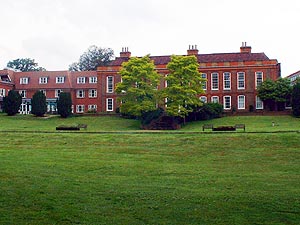Frognal House
51°25′4″N 0°6′18″E / 51.41778°N 0.10500°E


Frognal House is a Jacobean mansion in London, England, standing on the border of Sidcup in the London Borough of Bexley, and Chislehurst, in the London Borough of Bromley.[1] It was built in the early 16th century.[1]
History
A Jacobean mansion
Frognal House is believed to have been built sometime before 1550 by the Dyngley (or Dynely) family, on land obtained by
The Warwicks
In 1649 Watkins sold Frognal House to
The Tryons
Though the Tryon family were from working class origins, Rowland Tryon had become wealthy trading in the
The Townshends
Frognal House was purchased by
Hospital and modern use
The house was then subsequently used as the original building of the Queen's Hospital (later Queen Mary's Hospital), Sidcup, developed as the First World War's major centre for facial and plastic surgery, largely through the efforts of Harold Gillies. Opened in 1917, the hospital and its associated convalescent hospitals provided over 1,000 beds, and between 1917 and 1921 admitted in excess of 5,000 servicemen. The original hospital closed in 1929, re-opening the following year under the management of London County Council.
In 1974, a new Queen Mary's Hospital was built to replace the original Great War hospital, and since November 1999 Frognal House has been a residential and nursing home run by Sunrise Senior Living, their first location in the United Kingdom. In 2021, the property was taken over by Signature Senior Lifestyle.
The house gave its name to the nearby Frognal Corner, once a crossroads
References
- ^ a b c d e f g h i j k l m n "Frognal". bexley.gov.uk. Archived from the original on 14 February 2016. Retrieved 17 November 2016.
- ^ Darwin archives, University of Cambridge
- ^ Photograph of Frognal Corner in 1936 Archived 2006-09-05 at the Wayback Machine
- ^ History of A222 at SABRE
Bibliography
- Tester, P. J. (1981). "Frognal House, Sidcup" (PDF). Archaeologia Cantiana. 97: 305, 307.
